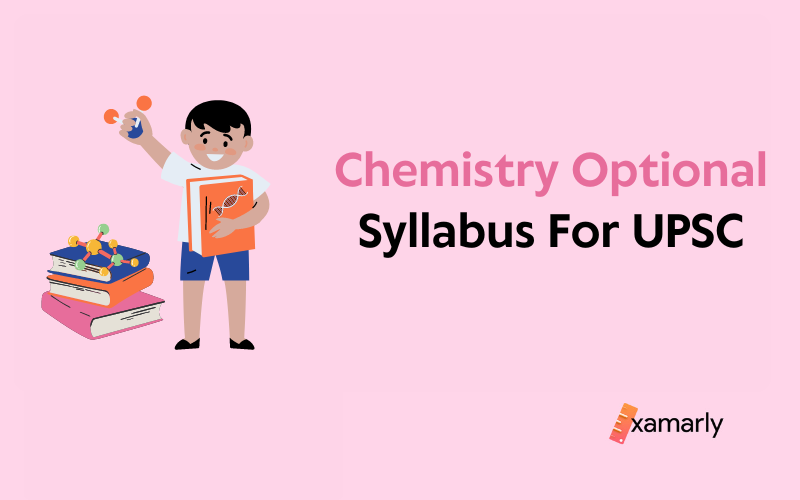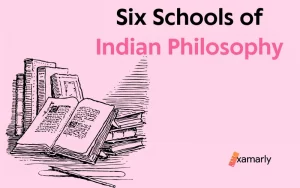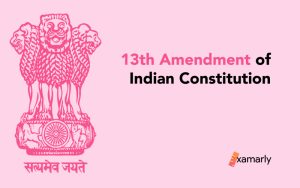Candidates who have completed a bachelor’s or master’s degree in chemistry would find the Chemistry optional Syllabus for UPSC to be useful. Chemistry is a subject that can be scored since equations and diagrams can receive a good grade. There is less competition in chemistry because lesser candidates choose to take it as an optional subject, and the majority of the UPSC chemistry syllabus is static.
In the UPSC Mains Exam, questions in the chemistry paper are generally of graduation or honors level, hence it is good for the hopefuls who have a chemistry background. Candidates from any other academic background will find this subject difficult to grasp.
Read this article to know the entire syllabus of chemistry optional for UPSC. The article is not limited to the syllabus only. It also helps you with the preparation strategy, and books to refer to, and also this article answers your other queries related to this topic.
- Chemistry Optional Syllabus For UPSC
- Exam Pattern
- Best Books for UPSC Chemistry
- Conclusion
- FAQs On Syllabus Of Chemistry Optional For UPSC
- Is It Good To Take Chemistry As An Optional Subject For The UPSC CSE Exam?
- Is There Anyone Who Cracks UPSC With Chemistry As Optional?
- Can Chemistry Be Preferred As An Optional Subject For UPSC?
- Can One Study For The UPSC Prelims and Chemistry Optional Syllabus At The Same Time?
- Which Of The Three Optional Subjects For The IAS, Physics, Chemistry, And Mathematics, Is The Best?
- What Are The Benefits Of Understanding The UPSC Syllabus?
Chemistry Optional Syllabus For UPSC
Chemistry Optional UPSC Syllabus Of Paper I
1. Atomic Structure :
Heisenberg’s uncertainty principle Schrodinger wave equation (time independent); Interpretation of wave function, particle in one- dimensional box, quantum numbers, hydrogen atom wave functions; Shapes of s, p, and d orbitals.
2. Chemical bonding :
Ionic bond, characteristics of ionic compounds, lattice energy, Born-Haber cycle; covalent bond and its general characteristics, polarities of bonds in molecules and their dipole moments; Valence bond theory, the concept of resonance and resonance energy; Molecular orbital theory (LCAO method); bonding H2 +, H2 He2 + to Ne2, NO, CO, HF, CN–, Comparison of valence bond and molecular orbital theories, bond order, bond strength, and bond length.
3. Solid State :
Crystal systems; Designation of crystal faces, lattice structures, and unit cell; Bragg’s law; X-ray diffraction by crystals; Close packing, radius ratio rules, calculation of some limiting radius ratio values; Structures of NaCl, ZnS, CsCl, CaF2; Stoichiometric and nonstoichiometric defects, impurity defects, semi-conductors.
4. The Gaseous State and Transport Phenomenon :
Equation of state for real gases, intermolecular interactions, critical phenomena, and liquefaction of gases; Maxwell’s distribution of speeds, intermolecular collisions, collisions on the wall and effusion; Thermal conductivity and viscosity of ideal gases.
5. Liquid State :
Kelvin equation; Surface tension and surface energy, wetting and contact angle, interfacial tension and capillary action.
6. Thermodynamics :
Work, heat, and internal energy; first law of thermodynamics.
The second law of thermodynamics; entropy as a state function, entropy changes in various processes, entropy-reversibility and irreversibility, Free energy functions; Thermodynamic equation of state; Maxwell relations; Temperature, volume, and pressure dependence of U, H, A, G, Cp and Cv, ??and?? ; J-T effect and inversion temperature; criteria for equilibrium, the relation between equilibrium constant and thermodynamic quantities; Nernst heat theorem, the introductory idea of the third law of thermodynamics.
7. Phase Equilibria and Solutions :
Clausius-Clapeyron equation; phase diagram for a pure substance; phase equilibria in binary systems, partially miscible liquids—upper and lower critical solution temperatures; partial molar quantities, their significance, and determination; excess thermodynamic functions and their determination.
8. Electrochemistry :
Debye-Huckel theory of strong electrolytes and Debye-Huckel limiting Law for various equilibrium and transport properties.
Galvanic cells, concentration cells; electrochemical series, measurement of e.m.f. of cells and its applications fuel cells and batteries.
Processes at electrodes; double layer at the interface; rate of charge transfer, current density; overpotential; electroanalytical techniques: amperometry, ion selective electrodes, and their use.
9. Chemical Kinetics:
Differential and integral rate equations for zeroth, first, second, and fractional order reactions; Rate equations involving reverse, parallel, consecutive, and chain reactions; Branching chain and explosions; effect of temperature and pressure on rate constant. Study of fast reactions by stop-flow and relaxation methods. Collisions and transition state theories.
10. Photochemistry:
Absorption of light; decay of excited state by different routes; photochemical reactions between hydrogen and halogens and their quantum yields.
11. Surface Phenomena and Catalysis:
Adsorption from gases and solutions on solid adsorbents; Langmuir and B.E.T. adsorption isotherms; determination of surface area, characteristics, and mechanism of reaction on heterogeneous catalysts.
12. Bio-inorganic Chemistry:
Metal ions in biological systems and their role in ion transport across the membranes (molecular mechanism), oxygen-uptake proteins, cytochromes, and ferredoxins.
13. Coordination Chemistry :
(i) Bonding in the transition of metal complexes. Valence bond theory, crystal field theory, and its modifications; applications of theories in the explanation of magnetism and electronic spectra of metal complexes.
(ii) Isomerism in coordination compounds; IUPAC nomenclature of coordination compounds; stereochemistry of complexes with 4 and 6 coordination numbers; chelate effect and polynuclear complexes; trans effect and its theories; kinetics of substitution reactions in square-planar complexes; thermodynamic and kinetic stability of complexes.
(iii) EAN rule, Synthesis structure and reactivity of metal carbonyls; carboxylate anions, carbonyl hydrides, and metal nitrosyl compounds.
(iv) Complexes with aromatic systems, synthesis, structure, and bonding in metal olefin complexes, alkyne complexes, and cyclopentadienyl complexes; coordinative unsaturation, oxidative addition reactions, insertion reactions, fluxional molecules, and their characterization; Compounds with metal-metal bonds and metal atom clusters.
14. Main Group Chemistry:
Boranes, borazines, phosphazenes and cyclic phosphazene, silicates and silicones, Interhalogen compounds; Sulphur—nitrogen compounds, and noble gas compounds.
15. General Chemistry of ‘f’ Block Element:
Lanthanides and actinides: separation, oxidation states, magnetic and spectral properties; lanthanide contraction.
Chemistry Optional UPSC Syllabus Of Paper II
1. Delocalised Covalent Bonding :
Aromaticity, anti-aromaticity; annulenes, azulenes, tropolones, fulvenes, and sydnones.
2. (i) Reaction mechanisms: General methods (both kinetic and non-kinetic) of study of mechanisms or organic reactions: isotopies, method cross-over experiment, intermediate trapping, stereochemistry; the energy of activation; thermodynamic control and kinetic control of reactions.
(ii) Reactive intermediates: Generation, geometry, stability, and reactions of carbenium ions and carbanions, free radicals, carbenes, benzynes, and nitrenes.
(iii) Substitution reactions:—SN 1, SN 2, and SN I, mechanisms; neighboring group participation; electrophilic and nucleophilic reactions of aromatic compounds including heterocyclic compounds—pyrrole, furan, thiophene, and indole.
(iv) Elimination reactions:—E1, E2, and E1cb mechanisms; orientation in E2 reactions—Saytzeff and Hoffmann; pyrolytic syn elimination—acetate pyrolysis, Chagaev and Cope eliminations.
(v) Addition reactions:—Electrophilic addition to C=C and C?C; nucleophilic addition to C=O, C?N, conjugated olefins and carbonyls.
(vi) Reactions and Rearrangements:—(a) Pinacol-pinacolone, Hoffmann, Beckmann, Baeyer-Villiger, Favorskii, Fries, Claisen, Cope, Stevens, and Wagner—Meerwein rearrangements.
(b) Aldol condensation, Claisen condensation, Dieckmann, Perkin, Knoevenagel, Witting, Clemmensen, Wolff-Kishner, Cannizzaro, and von Richter reactions; Stobbe, benzoin, and acyloin condensations; Fischer indole synthesis, Skraup synthesis, Bischler-Napieralski, Sandmeyer, Reimer-Tiemann, and Reformatsky reactions.
3. Pericyclic reactions:—Classification and examples; Woodward-Hoffmann rules—electrocyclic reactions, cycloaddition reactions [2+2 and 4+2] and sigmatropic shifts [1, 3; 3, 3 and 1, 5], FMO approach.
4. (i) Preparation and Properties of Polymers: Organic polymers polyethylene, polystyrene, polyvinyl chloride, Teflon, nylon, terylene, synthetic and natural rubber.
(ii) Biopolymers: Structure of proteins, DNA and RNA.
5. Synthetic Uses of Reagents:
OsO4, HlO4, CrO3, Pb(OAc)4, SeO2, NBS, B2H6, Na-Liquid NH3, LiAIH4, NaBH4, n-BuLi, MCPBA.
6. Photochemistry:—Photochemical reactions of simple organic compounds, excited and ground states, singlet and triplet states, Norrish-Type I and Type II reactions.
7. Spectroscopy:
Principle and applications in structure elucidation :
(i) Rotational—Diatomic molecules; isotopic substitution and rotational constants.
(ii) Vibrational—Diatomic molecules, linear triatomic molecules, specific frequencies of functional groups in polyatomic molecules.
(iii) Electronic—Singlet and triplet states. n??? and ???? transitions; application to conjugated double bonds and conjugated carbonyls Woodward-Fieser rules; Charge transfer spectra.
(iv) Nuclear Magnetic Resonance (1HNMR): Basic principle; chemical shift and spin-spin interaction and coupling constants.
(v) Mass Spectrometry:—Parent peak, base peak, metastable peak, McLafferty rearrangement.
Exam Pattern
- An applicant must select one subject for their optional. It holds 500 marks on the UPSC Mains exam.
- The UPSC Chemistry Syllabus covers fundamental chemistry topics, hence candidates must understand the fundamental ideas.
- The atomic structure, diverse states of matter, and many types of reactions are just a few of the topics covered in the Chemistry Optional test syllabus.
- Candidates with graduate-level Chemistry education can use the syllabus. Before selecting any options, candidates should first review the curriculum.
- There are two papers in the IAS (UPSC CSE) Main Exam, and the chemistry optional is a scoring option. Each Chemistry paper has 250 points.
To know more about UPSC Exam Pattern, visit the linked article.
How To Cover The Syllabus?
For the UPSC examination, candidates can prepare for chemistry as an optional subject. The syllabus for UPSC chemistry optional has two papers of 250 marks each.
To achieve high test scores, it is crucial to cover the entire syllabus for chemistry optional in UPSC preparation. We have therefore developed a successful study plan that will enable you to thoroughly cover the UPSC chemistry syllabus-
- Have a solid grasp of the UPSC chemistry syllabus and be knowledgeable about the subjects it covers.
- Make sure you review the UPSC question papers from prior years and try to comprehend the parts of the chemistry syllabus that are frequently tested.
- Create brief notes for each topic and read them thoroughly before the exam.
- After finishing a topic from the UPSC chemistry curriculum, regularly review it to improve retention.
Best Books for UPSC Chemistry
Refer to the following books to prepare for the UPSC Mains Chemistry Optional Subject:
- A guide to mechanism in organic chemistry – Peter Sykes
- Organic Chemistry Reactions and reagents – O.P. Agarwal
- Principle of physical chemistry – Puri, Sharma
- Advanced Inorganic Chemistry – J.D. Lee
- A textbook of environmental chemistry and pollution – S.S. Dara.
- A textbook of organic chemistry – Bahl & Ba
- A textbook of physical chemistry (Vol. – IV) – K.L. Kapoor
- Extradition of metals, Principle of inorganic chemistry – Puri, Sharma, Jauhar
Conclusion
IAS Chemistry needs a high level of skill, hence early exam preparation is advised. You must ensure that you are entirely familiar with the optional subject’s syllabus to receive high scores in it. You should be aware of the topics that should be given more attention and priority according to the curriculum. With such crucial information, any candidate can do well in the optional.
FAQs On Syllabus Of Chemistry Optional For UPSC
Is It Good To Take Chemistry As An Optional Subject For The UPSC CSE Exam?
Since chemistry is a precise discipline as opposed to the humanities or social sciences, it is regarded as a high-scoring topic. Nothing is subjective and the concepts cannot be understood in different ways. This increases the predictability of the marking.
Because there is plenty of room for equations and illustrations, chemistry is a subject that scores well. In this paper, there are additional numerical questions that, if answered correctly, can get you the maximum points. Additionally, you can write strong responses and receive high marks if your concepts are clear. The competition you will encounter with this choice is fairly low due to the small number of candidates who choose it.
Is There Anyone Who Cracks UPSC With Chemistry As Optional?
There have been UPSC exam top scorers who chose the chemistry option. Ankur Garg, the top student in 2002, chose chemistry as one of his optional subjects.
Can Chemistry Be Preferred As An Optional Subject For UPSC?
Yes, this can be preferred as an optional subject for UPSC. There are several advantages to choosing Chemistry as an optional subject. It has an excellent syllabus and is a subject that you are likely to have studied at some point in your academic career. It is a fundamental science subject, and those with a science background at the graduate level typically choose it. Because science is a subject, there is very little room for subjectivity on the part of the examiner.
Can One Study For The UPSC Prelims and Chemistry Optional Syllabus At The Same Time?
It is possible to study both the UPSC prelims and chemistry syllabi at the same time. However, aspirants must make sure that it won’t affect their preparation for the UPSC prelims.
Which Of The Three Optional Subjects For The IAS, Physics, Chemistry, And Mathematics, Is The Best?
In all fairness, it should be emphasized that there is no easy option for the UPSC since a candidate’s skill dictates whether optional can be more to his or her taste. However, the popularity element should be taken into account when choosing the IAS mains optional because a popular subject has both subject material and experts easily available. So choose any optional subject according to your educational background and interest.
What Are The Benefits Of Understanding The UPSC Syllabus?
When candidates review the syllabus, they become aware of the common subjects that must be covered for both the preliminary and main exams. These topics can be studied by combining the Mains and Prelims exam scopes. This not only makes preparing easier, but it also helps you save time. A candidate risked studying both useful and irrelevant material if he continued to study without first reviewing the syllabus. The applicants will waste their most precious time during this process. Analyzing the UPSC Prelims and Mains curriculum before beginning the preparation is essential to avoid this.






